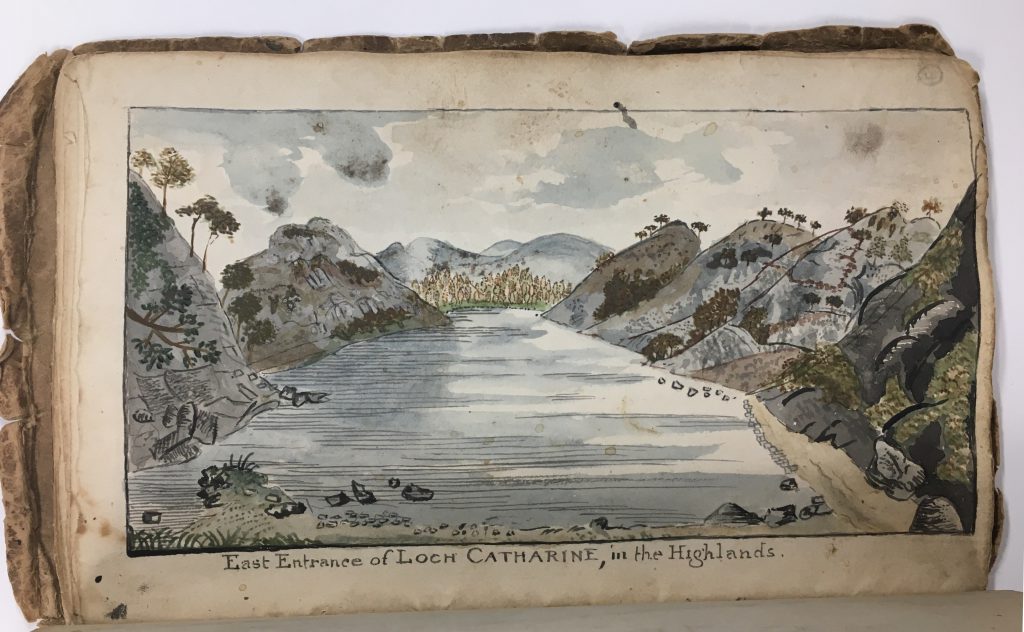The choice: Tours of Scotland
Chosen by: Kirsty McHugh, Curator, John Murray Archive & Publishers’ Collections
Read online at the Curious Travellers website
Welcome to the third in our blog series where we introduce you to some favourites from our collections for you to enjoy reading, all freely available online.
In this blog, rather than focus on a book from our digital gallery, we invite you to explore some of our manuscript collections, through transcripts produced as part of the Curious Travellers research project and published on their website.

The Library has built up a collection of unique archives and manuscripts over many years, and we add to our collections all the time. Today our collections contain around 150 handwritten journals compiled by tourists as a record of their holidays in Scotland between the 17th and the 20th century. These are interesting both because they include descriptions of places in the past and also provide an insight into how visitors perceived Scotland. People have been coming to Scotland for hundreds of years to explore its culture and scenery, but it was particularly popular from the late 18th century. The tours published on the Curious Travellers website, which include five from our collections, focus on the period 1760-1820. By this time standard routes and tourist sites had been established, many of which are still popular today.
If you are missing rambling in the Scottish countryside and want to experience the view from Ben Lomond or take a vicarious boat ride on Loch Katrine then I’d recommend having a look at these Scottish tours. (They are often structured as daily entries lending them to being read in instalments if you just want to dip into them.) Tourists sought to capture all sorts of information about their experiences of Scotland, so you will find comments on topics such as natural landscape, antiquities, architecture, customs, society, costumes and fashions, art, country estates, theatres, museums, factories, schools, prisons, bridges, agriculture, the local people, inns, food, the weather….
You may find some archaic terms or old spellings (especially of place names), but the online editions contain many explanatory notes: the texts are quite easy to read and their narrators are often lively travelling companions.
Sixteen-year-old Eliza Dawson from Yorkshire, who visited Scotland with her father in 1786, introduces her journal telling her reader she will use her journal to record ‘every trifling circumstance’. One of her favourite places was Kenmore: ‘I sincerely wish every one who has a true taste for the beauties of nature to visit the Hermitage at Taymouth. — after seeing it how dull and insipid is the stiff cut avenue and gravel walk.’
She is particularly appreciative of the Hermitage, a type of folly which was fashionable in this period:
‘Art has little hand in it and Nature reigns predominant. — It is a steep glen in the midst of which are high and rugged rocks, over them rush large sheets of waters, which form the most beautiful cascades imaginable. — the sides of these rocks are cover’d with trees shrubs and wild flowers. – One is lead by a winding path to a door which conveyed us through a dark subteranuous passage. — hewn out of an astonishing rock…’
Elizabeth Susannah Graham toured Scotland with her daughter Maria in 1818. In her journal she refers to making sketches, a popular pastime for tourists, but she found the ‘velocity’ of the new steamboats ‘not quite agreeable to the sketcher’. In her descriptions, Graham often shows an artistic eye, such as her description of their walk near Inveraray, which leads us through the landscape:
‘Soon after we emerged from the woods and entered a very barren tract with rugged mountains on each side constantly ascending and the river still roaring by our side; when we had almost traced it to it’s source and reached the summit of the mountain we had a magnificent view down upon Loch Awe and it’s Islands; Ben Cruachan rearing it’s tremendous form on the opposite side. Descending a steep road to Clady that village with its trees made a fine foreground, two islands in the lake had a striking appearance, one rocky and covered with deep green wood and enveloped in shade, another of a fine undulating outline covered with grass and a yellow light playing upon it, behind the branch of the lake which goes North towards Bunawe and has gloomy mountains on each side of it had a singular appearance…’
You can read more by following the links below.
Look out in two weeks for our next Curator’s Favourite, and in the meantime enjoy reading!
If you are interested in local history please also look out for the new ‘Zoom Into Scotland’ blog series starting later this month.
The tours
A Tour Through part of the Highlands of Scotland by Jacob Pattisson, 1780 (MS. 6322)
A Tour through part of England and Scotland By Eliza Dawson in the Year 1786 (Acc.12017)
Tour in Scotland August 1794 (Acc.8278)
Diary of a trip from Edinburgh to Iona, 1807 (Acc.8625)
A Tour to the West of Scotland, 1817 (Acc.13028)
Tour in Scotland by Elizabeth Susannah Graham, 1818 (Acc. 13509)